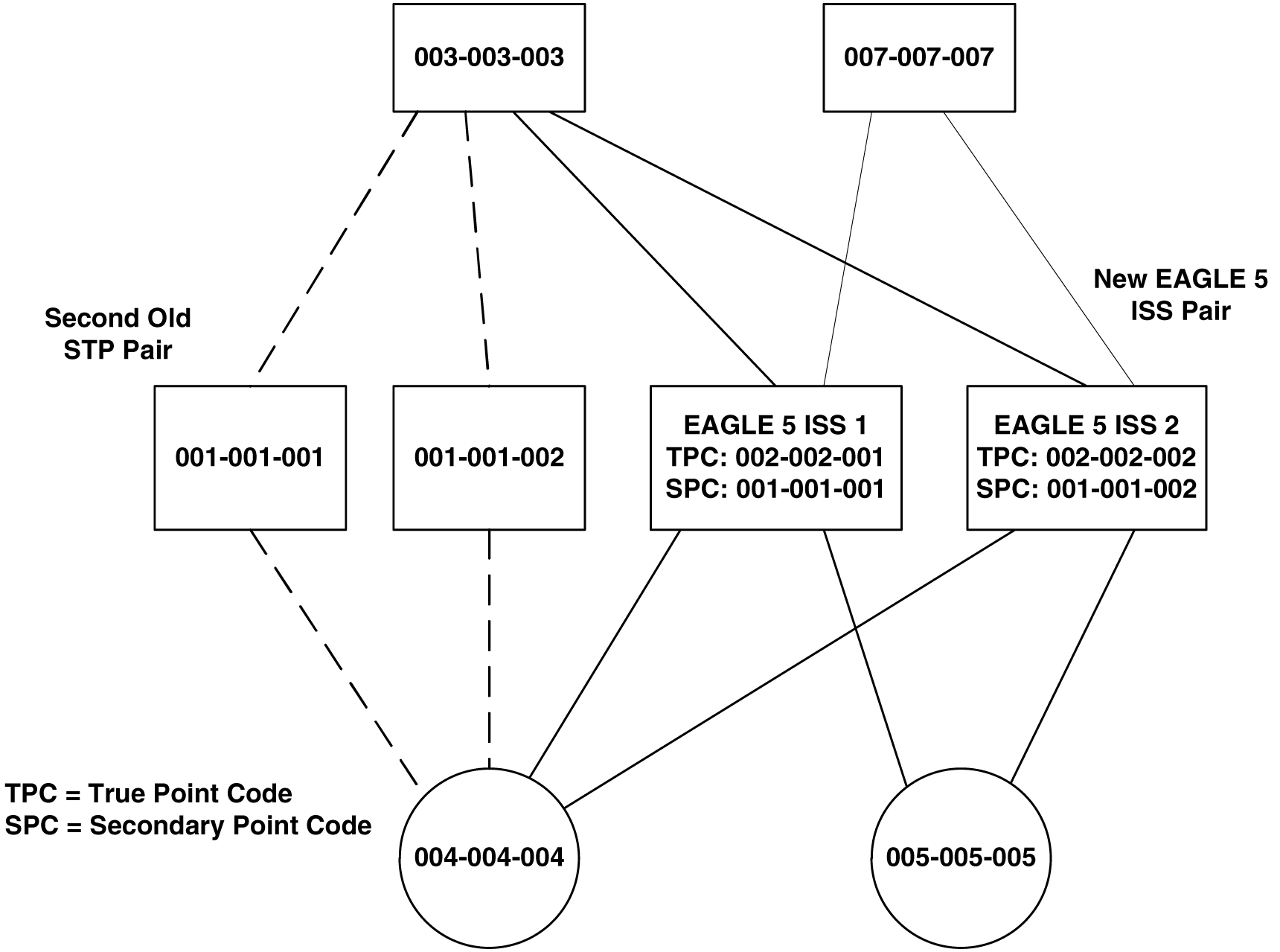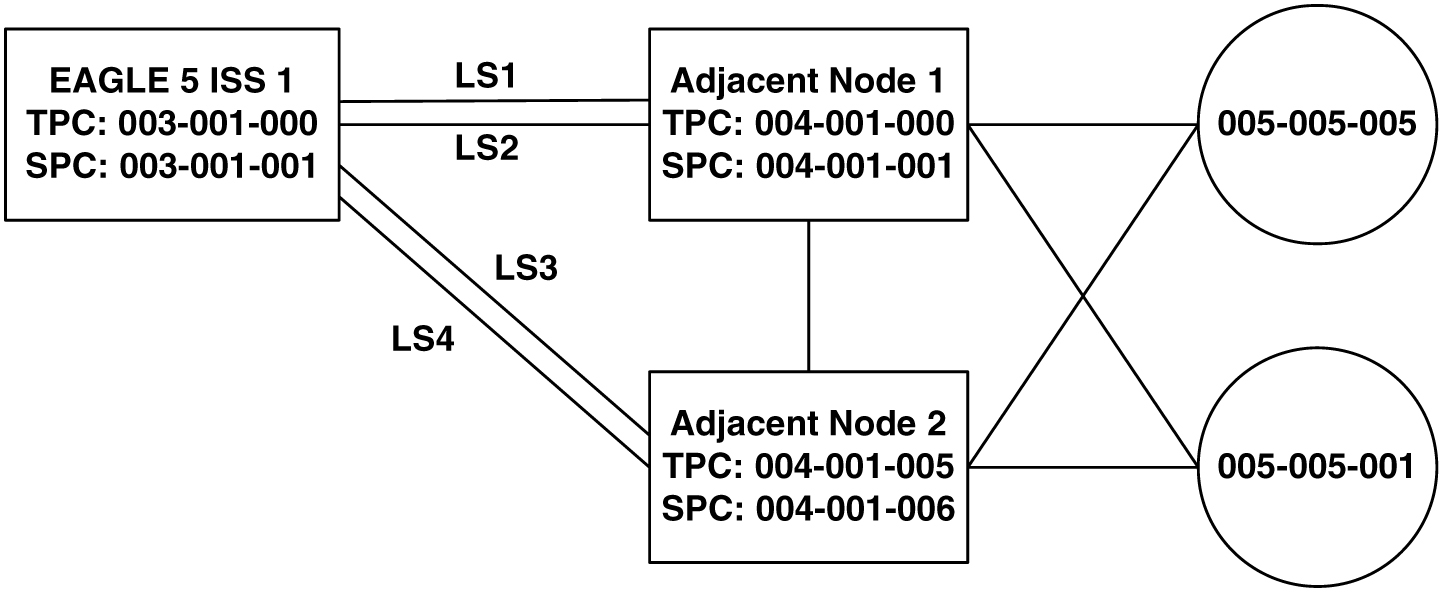| Oracle® Communications EAGLE Database Administration - SS7 User's Guide Release 46.7 E97335 Revision 1 |
|
 Previous |
 Next |
| Oracle® Communications EAGLE Database Administration - SS7 User's Guide Release 46.7 E97335 Revision 1 |
|
 Previous |
 Next |
Currently, the EAGLE supports six true point codes:
Note:
The ITU national point code can be either 14-bit ITU national - spare and non-spare - or 24-bit ITU national. Both 14-bit ITU national and 24-bit national point codes cannot be present in the EAGLE at the same time.In addition, the EAGLE supports up to 96 capability point codes, each of which can be designated as either ANSI, ITU-I (spare and non-spare), 14-bit ITU-N (spare and non-spare), or 24-bit ITU-N. Each capability point code defined on an EAGLE node can be used for routing messages to that node. For various reasons, customers might need the EAGLE to support more than one true point code in a particular domain.
There are three main reasons driving this feature:
This feature adds the ability to support Secondary Point Codes (SPCs) in addition to the true point codes used by the EAGLE in any of the three domains ANSI, ITU-N (14-bit or 24-bit) and ITU-I. Secondary point codes are used by provisioning and routing as if they are the true point code of the EAGLE. SPCs are supported for any type of link (A, B, C, D, etc.). There is no effect on provisioning capability point codes as a result of this feature.
In addition to the one True Point Code (TPC) already supported for each of the ANSI, ITU-N (14-bit or 24-bit) and ITU-I domains, the EAGLE support a pool of 40 Secondary Point Codes (SPC), each of which may be assigned as either ANSI, ITU-I, 14-bit ITU-N, or 24-bit ITU-N (not to exceed a total of 40 in one EAGLE). SPCs can be used in the same ways that true PCs are used.
Replacing Two STP Pairs with One Pair
The following example shows how an EAGLE pair can replace two existing STP pairs. In this example, each EAGLE in the pair uses one true point code and one secondary point code.
As shown in Figure 2-14, a new EAGLE first replaces one existing STP pair. In this case, EAGLE's true point code is set to the true point code of the old STP. The adjacent nodes are cut over to the EAGLE pair. The adjacent nodes do not need to be reconfigured.
Figure 2-14 Replacing the First STP Pair

Next, a second STP pair is replaced with the EAGLE pair. As shown in Figure 2-15, an SSP and an STP are being “re-homed” from an old STP pair to a new EAGLE pair. In this example, the STP (003-003-003) is reconfigured with new routes to recognize that it is now connected to EAGLE 1 and EAGLE 2 instead of 001-001-001 and 001-001-002. STP 003-003-003, if not an EAGLE with Multiple Point Codes, may not be able to support more than one linkset to the same point code. See Multiple Linksets between Two Nodes section for a description of this capability. The interconnecting device (STP or SSP) can use either the TPC or SPC as the device requires.
At EAGLE 1, the user would configure the secondary point code 001-001-001, using the ent-spc command. The user would also configure a route to 001-001-002 over the C-linkset. The user would then configure point code 004-004-004 in the EAGLE's database to indicate that this point code uses the secondary point code 001-001-001, instead of the EAGLE's true point code (chg-dstn:dpc=004-004-004:spc=001-001-001. This last step would be repeated for all other adjacent SSPs and SCPs that are re-homed from the old STP Pair to the new EAGLE Pair.
Similarly, at EAGLE 2, the user would configure the secondary point code 001-001-002, and configure a route over the C-link to 001-001-001. The user would also configure point code 004-004-004 in EAGLE 2's database to indicate that this point code uses the secondary point code 001-001-002, instead of the EAGLE's true point code.
When EAGLE 1 receives a message from the SSP destined for 001-001-001, the EAGLE 5 ISS processes the message as if the message was sent to the EAGLE's true point code.
When EAGLE 1 generates a message (for example, network management, link test messages, or GTT messages) that is destined for 004-004-004, EAGLE 1 puts the OPC 001-001-001 in the message. When EAGLE 5 ISS 1 generates a message that is destined for 003-003-003 or 005-005-005, it puts the OPC 002-002-001 in the message. When EAGLE 1 generates GTT and SCMG messages that are destined for non-adjacent point codes, it includes the OPC 002-002-001 in the message.
Figure 2-15 Replacing a Second STP Pair

Multiple Linksets between Two Nodes
With this feature, it is possible to configure multiple linksets between two nodes, if the adjacent node also supports Multiple Point Codes. The EAGLE continues to enforce the rule that each linkset must have a different adjacent point code.
One reason for provisioning multiple linksets between two nodes is to increase the number of links that can be configured between STP pairs. For example, in Figure 2-16, the EAGLE is connected to an STP pair that supports multiple point codes. Without this feature, only 16 ITU links can be configured between the EAGLE and the STP pair (8 links in LS1 and 8 links in LS2). In this example, two linksets are added, increasing the number of links to 32 (8 links in each of LS1, LS2, LS3, and LS4).
Figure 2-16 Multiple Linkset Example

In this example, the adjacent point code (APC) for LS1 is 4-1-0 and the APC for LS2 is 4-1-1. 4-1-1 is assigned an SPC of 3-1-1. So adjacent, Adj Node1 sees LS1 as having an APC of 3-1-0, and LS2 as having an APC of 3-1-1.
To load balance over these 4 linksets, half the destinations that use the STP pair can be assigned LS1 and LS3 as a combined linkset. The other half of the destinations can be assigned LS2 and LS4 as a combined linkset.
The commands to provision EAGLE1 for the network shown in Figure 2-16 are:
chg-sid:pc=3-1-0
ent-spc=3-1-1
ent-dstn:dpc=4-1-0
ent-dstn:dpc=4-1-1:spc=3-1-1
ent-dstn:dpc=4-1-5
ent-dstn:dpc=4-1-6:spc=3-1-1
ent-dstn:dpc=5-5-1
ent-dstn:dpc=5-5-5
ent-ls:lsn=ls1:apc=4-1-0
ent-ls:lsn=ls2:apc=4-1-1
ent-ls: lsn=ls3:apc=4-1-5
ent-ls: lsn=ls4:apc=4-1-6
ent-rte:dpc=4-1-0:lsn=ls1:rc=10
ent-rte:dpc=4-1-1:lsn=ls2:rc=10
ent-rte:dpc=4-1-5:lsn=ls3:rc=10
ent-rte:dpc=4-1-6:lsn=ls4:rc=10
ent-rte:dpc=5-5-1:lsn=ls1:rc=10
ent-rte:dpc=5-5-1:lsn=ls3:rc=10
ent-rte:dpc=5-5-5:lsn=ls2:rc=10
ent-rte:dpc=5-5-5:lsn=ls4:rc=10
Local Number Portability
Note:
Local number portability supports only ANSI point codes.The EAGLE allows only the true point code to be entered into the mated application table. Also, the EAGLE continues to allow the user to enter translations to the true point code. However, the EAGLE does not allow the user to enter translation to a secondary point code.
If a node sends a rt-on-gt query, the node should set the query's DPC to the EAGLE's capability point code. If a node sends an rt-on-ssn query, the node should set the query's DPC to the true point code or secondary point code used by that node. If the node has a secondary point code, then the query’s DPC is set to the secondary point code. If the node does not have a secondary point code, then the query’s DPC is set to the true point code.
rt-on-gt Queries from a Node That Uses Secondary Point Codes
Nodes that send rt-on-gt queries should use the capability point code, regardless of whether these nodes use a true or a secondary point code.
This TFP causes the node to divert traffic to the mate.
If a node sends an rt-on-gt query to either the EAGLE's true point code or a secondary point code, the EAGLE cannot divert traffic to the mate. In this case, the EAGLE does not send a TFP concerning the secondary point code or the true point code, so the node will not divert traffic to the mate.
rt-on-ssn queries from a Node That Uses Secondary Point Codes
It is possible that nodes using a secondary point code will send rt-on-ssn queries. In this case, these nodes should send the queries to the secondary point code. The EAGLE will accept rt-on-ssn queries from these nodes if the DPC is the true point code or a secondary point code. However, SCCP management will not work correctly if the rt-on-ssn queries do not use the true point code or a secondary point code associated with the sending node.
Limitations
The same adjacent point code cannot be used for two different links.
Local EAGLE subsystems (for example, LNP) must use the True Point Code.